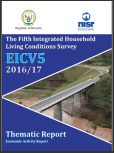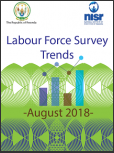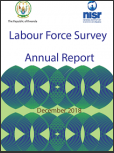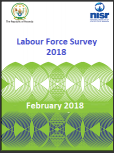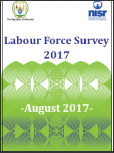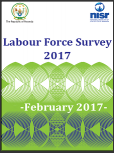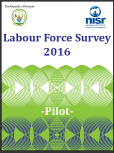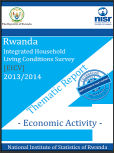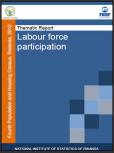EICV5_Thematic Report_Economic activity Thematic Report.pdf
The present report is one of six thematic reports produced from EICV5.
Labour Force Survey Trends-August 2018
The focus of the present report is the analysis of trends of employment and labour underutilization including unemployment at the national and province levels by selected demographic and socioeconomic characteristics such as sex, age group, educational attainment, occupation and industry. The analysis in this report covers four rounds extended to two years from February 2017 to August 2018.
Labour Force Survey Report December 2018
The current report presents the results of the annual report of 2018 LFS obtained by combining both rounds of LFS in 2018 (February and August 2018). The scope of the survey covered all persons living in private households, excluding the institutional population permanently residing in places such as hostels, health resorts, correctional establishments etc., as well as persons living at their work-sites and in seasonal dwellings.
Labour Force Survey Report (February 2018)
The National Institute of Statistics of Rwanda (NISR) introduced the Labour Force Survey (LFS) program to avail statistics on employment and labour market in Rwanda on a continuous basis, providing bi-annual estimates of the main labour force aggregates. Labour statistics play an essential role in the efforts of the country to achieve decent work for all. These statistics are needed for the development of policies towards this goal and for assessing progress towards decent work.
Labour Force Survey Report (August 2017)
The National Institute of Statistics of Rwanda (NISR) introduced the Labour Force Survey (LFS) program to avail statistics on employment and labour market in Rwanda on a continuous basis, providing bi-annual estimates of the main labour force aggregates. Labour statistics play an essential role in the efforts of the country to achieve decent work for all. These statistics are needed for the development of policies towards this goal and for assessing progress towards decent work.
Labour Force Survey Report (February 2017)
The National Institute of Statistics of Rwanda (NISR) introduced the Labour Force Survey (LFS) program to avail statistics on employment and labour market in Rwanda on a continuous basis, providing bi-annual estimates of the main labour force aggregates. Labour statistics play an essential role in the efforts of the country to achieve decent work for all. These statistics are needed for the development of policies towards this goal and for assessing progress towards decent work.
Labour Force Survey Report (August 2016)
The National Institute of Statistics of Rwanda (NISR) introduced the Labour Force Survey (LFS) program to avail statistics on employment and labour market in Rwanda on a continuous basis, providing bi-annual estimates of the main labour force aggregates. Labour statistics play an essential role in the efforts of the country to achieve decent work for all. These statistics are needed for the development of policies towards this goal and for assessing progress towards decent work.
Labour Force Survey Report - Pilot (February 2016)
The purpose of the present report is to analyze the results of the pilot Labour Force Survey (LFS) and to assess the survey instrument for possible modifications in preparation for the main survey to be conducted in August 2016. The analysis of the pilot LFS results is presented in the main body of the report. The presentation follows the layout of a full-fledge LFS report and is intended to provide a test of report writing and documentation of survey results.
EICV 4 THEMATIC REPORT - Economic Activity
The six thematic reports in this series are: (i) Economic Activity; (ii) Utilities and Amenities (water/sanitation/energy/housing/transport/ICT); (iii) Environment and Natural Resources; (iv) Gender; (v) Youth; (vi) Education.
RPHC4 Thematic Report: Labour Force Participation
The Rwandan labour market is predominated by agriculture (73%).A higher percentage of employed females is employed in agriculture (82%) compared to males (63%) and a higher percentage of employed persons in rural areas is farmers(83%) compared to those in urban areas (21%).
Non-agricultural occupations in urban areas were mainly services and sales workers and craft and related trades workers. Except for agricultural and clerical support workers, men predominated in all other occupations.

